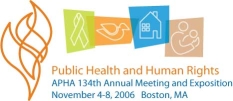 Back to Annual Meeting
|

|
 Back to Annual Meeting
|
APHA Scientific Session and Event Listing |
 Back to Annual Meeting
|

|
 Back to Annual Meeting
|
APHA Scientific Session and Event Listing |
Jean Slosek, MS, Catherine (Kay) Sanford, MSPH, and Jeanne Givens, MSSW. Injury and Violence Prevention Branch, Division of Public Health, North Carolina Department of Health and Human Services, State of North Carolina, 1915 Mail Service Center, Raleigh, NC 27699-1915, 919-707-5434, Kay.Sanford@ncmail.net
Purpose: Robeson County is a rural, ethnically and racially diverse county in North Carolina (25% African American; 5% Hispanic; 39% American Indian; 31% White/Other). The county's demographic and socioeconomic profile is markedly different from the state's profile. Upon recognizing the variation in injuries by race and ethnicity in their county, representatives from its racial/ethnic communities are using data to guide the development of an injury prevention plan.
Methods: Using death certificate data and population estimates for 1999-2003, injury-related mortality statistics were prepared using the CDC/ICE recommended ICD-10 Framework: External Cause of Injury Mortality Matrix. Injury data included the number of deaths and death rates per 100,000 population for Robeson County and North Carolina by year, age, race/ethnicity and sex for all recommended categories of mechanism/cause and manner/intent.
Results: Between 1999 and 2003, Robeson County's age-adjusted death rate for motor vehicle crashes (46.9) was almost 2.5 times the state rate (19.1). The County's homicide rate (20.8) was nearly three times higher than the state rate (7.1). Age-specific rates for all injury-related deaths were markedly higher in Robeson County than the state for all age groups under age 85. Robeson County's death rates for all injuries were highest among American Indians (123.0), but varied by mechanism and intent. The highest death rates for motor vehicle crashes (64.5) and homicide (23.5) were among Latinos.
Conclusion: County-level, descriptive injury death data by age, race/ethnicity and sex can be an essential component of grass-roots, evidence-based, injury prevention planning in racially and ethnically diverse communities.
Learning Objectives:
Keywords: Health Disparities, Surveillance
Presenting author's disclosure statement:
Not Answered
The 134th Annual Meeting & Exposition (November 4-8, 2006) of APHA